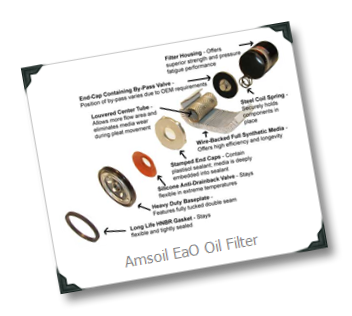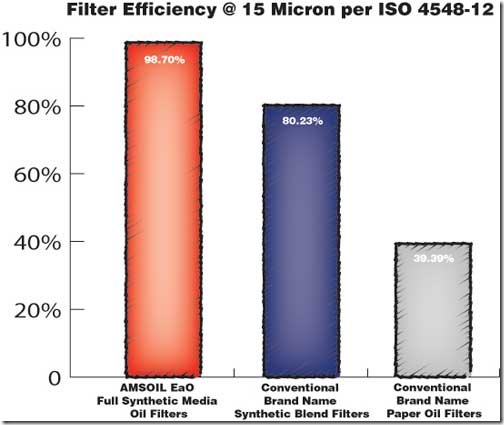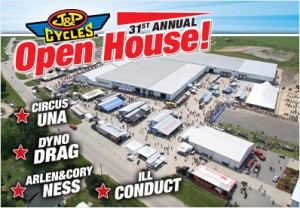64 WAYS TO MAKE YOUR CAR LAST LONGER Using Amsoil
Every 2 weeks or 3,000 miles:
1. Check engine oil, transmission fluid and coolant. Check your wife’s car, too.
Once a month or 1,000 miles:
2. Check tire pressure – with tire gauge. Accuracy counts.
3. Check transmission fluid.
4. Check brake fluid.
5. Wax car (to protect finish).
6. Check belts and hoses.
Every 3 months or 3,000 miles:
7. Change Amsoil synthetic oil and oil filter per specs, depending on which oil you’re using. 7500 miles/6 months for Amsoil XL series, and for Amsoil synthetics; up to 35,000 miles or one year, whichever comes first for normal service. Replace AMSOIL Ea oil filter at the  time of oil change up to 25,000 miles or one year, whichever comes first (other brands at standard OEM* intervals).
time of oil change up to 25,000 miles or one year, whichever comes first (other brands at standard OEM* intervals).
8. Lubricate chassis. Many new cars don’t have grease fittings, but find out for your car. Use a good quality synthetic grease.
9. Check transmission fluid.
10. Check all drive belts (fan belts) frayed or cracked belts.
Every 6 months or 6,000 miles:
11. Change oil and filter (Amsoil synthetic oil, per manufacturer specs).
12. Inspect suspension.
13. Rotate tires.
Every 12 months or 12,000 miles:
14. Flush radiator, replace anti-freeze, check air conditioning system.
15. Replace air filters. For comfort, replace cabin air filters available from Amsoil as well.
16. Lubricate chassis.
Every 2 years or 24,000 miles.
17. Replace spark plugs (30,000 miles average suggested for
unleaded gas) and PC valve.
18. Change automatic transmission fluid, filter and pan gasket. Replace with proper Amsoil synthetic ATF.
19. Inspect brake linings.
Every 3 years or 30,000 miles:
20. Check and test ignition wires (replace if needed).
21. Test cooling system and heating hoses (replace if needed).
22. Check drive belts (replace if needed).
23. Replace fluid in differential and manual transmission. Use Amsoil Synthetics for increased fuel economy and extended drains.
Every 50,000 miles.
24. Check brake shoes (replace if needed).
25. If you have a major repair to do, it’s wise to get at least 3 estimates, if possible, before you decide.
26. Read and follow your car owner’s manual – it’s your car’s bible for making your car last longer.
27. Whether you are a man, woman, boy or girl, learn to do some routine maintenance on your car yourself. A multitude of books, videos, magazines and classes are available at your local library that will teach you for free if you don’t know. Learn how to check your own oil, transmission fluid, tire pressure and coolant, etc. You won’t be a victim for unscrupulous shops if you’re knowledgeable.
28. If you find a good mechanic who you can trust, stick with him even if his prices are a bit higher – all things being equal. You’ll always save time, money and aggravation in the long run.
29. Don’t race or gun your engine when you start it up. Accelerate slowly and smoothly when your engine is cold.
30. Avoid burning rubber – it places excessive wear on the transmission, rear end, not to mention your tires. Even though it’s really fun, try to restrain yourself. I know it’s hard.
31. An international tire company estimated that 33% of all tires on the road are under-inflated (low air). Under-inflated tires wear out quicker and have a tendency to blow out easier. They also take more power, and thus, more fuel to roll down the road.
32. A garaged car lasts longer. A car port is next best, and a car cover is a distant third.
33. Avoid jackrabbit starts and stops. Stop and accelerate gradually.
34. Avoid tailgating, tire squealing turns, flying over speed bumps, pot holes and revving your engine.
35. When possible, avoid driving your car during rush hour stop and go traffic periods.
36. Keep front-end aligned, for longer tire life and better gas mileage.
37. Make sure you get promised repairs in writing including how
much it will cost.
38. Avoid car dealers except to have highly specialized repairs done that can’t be done properly anywhere else.
39. It’s hard to be overcharged when you get three estimates before you have the work done.
40. Beware: Cheapest is not always the best. Normally, the best mechanics with the best equipment and training cost more.
41. Often mechanics that charge extremely low prices have inferior or out-dated equipment, little to no formal training or are under-insured.
42. Complex electrical problems are so involved that serious electrical work should be done in an "Auto Electric" shop. They have the equipment, tool and training to do the job more efficiently than the average mechanic.
43. If your car has "Cruise Control" use it. Using cruise control will save you 5% to 10% of a gallon of gas on long trips.
44. Avoid constantly pressing and releasing the accelerator when driving. This practice not only wastes fuel, but it puts excessive wear on the drive train of your car.
45. Don’t ride your brake pedal, this wears out your brake linings pre-maturely, and wastes fuel.
46. Driving with your windows all the way down at higher speeds, will waste 10% more gallons of gasoline than driving with them closed.
47. Research by a major car manufacturer has revealed that neglect of proper routine maintenance is the number one reason for the enormous increase in car repairs being required.
48. Tires purchased at department stores such as Sears, Montgomery Wards, K-Mart etc., can be an excellent value because many are made by leading tire manufacturers. For a list of what manufacturer makes which tires for what department store, write
to: Tire Information Center, P.O. Box 677, Syosset, NY 11791
49. When purchasing or changing tires, make sure you have them spin balanced.
50. Avoid cleaning your windshield with a dry rag or towel. Always dampen with water or some other cleaning liquid. Dry towels grind and scratch your windshield hindering your visibility.
51. Avoid turning on the car air-conditioning while running at highway speeds as this tends to put an immediate heavy load on your compressor and clutch. This could cause excessive wear and tear on these components. Instead turn your air conditioner on
at car speeds below 25 to 30 m.p.h. This helps to preserve your expensive compressor.
52. Try to avoid running your car with the tank low on gas. Keeping a low tank of gas increases the chance of dirt, water/moisture and rust forming in your fuel system. Keeping a full tank decreases the chance of dirt and other foreign matter forming in
your fuel system.
53. Tires driven at 70 m.p.h. wear out almost twice as fast as cars that go 50 m.p.h.
54. A government study has confirmed, the top three causes of car breakdowns while on the road are: (a) running out of gas (b) tire troubles (c) cooling system problems (overheating).
55. The best as well as the easiest ways to find a good car repair shop is by recommendation or referrals from satisfied customers.
56. To work on a late model computer-controlled engines, make sure the shop you choose has the equipment to handle computer-electric service/repair. Sophisticated diagnostic equipment is a must.
57. To choose the right repair shop for you, it’s wise to have a small or minor maintenance or repair job done first to see how the repair shop and mechanic treat you and your car.
58. Give detailed description of your car’s problem when you take it in for repairs. The more you can describe what your car is doing or not doing (thumping, squealing, clacking sound, etc.) the faster and less it will cost for your mechanic to fix it.
59. When in doubt about the cost of a repair or a mechanic’s honesty get a second opinion. This is one of the best ways to protect yourself from being ripped-off until you can find a permanent repair shop.
60. Regular oil changes are the most important thing you can do to protect your engine and make it last longer.
61. If you have a manual transmission, downshift to slow your car down instead of using your brakes. This will save wear and tear on your braking system.
62. Each time you have your engine oil checked, have your transmission fluid checked also.
63. Protect your car’s interior and make it last longer – park your car in the shade or place a windshield guard or cover in the windshield.
64. If you spill something inside your car, clean it up
immediately before it dries. Delaying even 30 minutes can
sometimes leave a permanent stain or spot. NOTE: To better
protect your car seats have them treated with scotch guard.
NOTE: According to current auto insurance statistics, the
average U.S. car’s useful life is 10 years or 100,000 miles. By
following proper preventative maintenance you can often double
your car’s useful life, and spend less time visiting your local
mechanic.
I’ve had multiple cars I’ve run well over 100,000 miles, and some over 200,000 miles. I currently own a 2000 Plymouth Neon with 204,000 miles that runs great, using all Amsoil products.



 time of oil change up to 25,000 miles or one year, whichever comes first (other brands at standard OEM* intervals).
time of oil change up to 25,000 miles or one year, whichever comes first (other brands at standard OEM* intervals).  J&P Cycles® 31st Annual Open House
J&P Cycles® 31st Annual Open House


